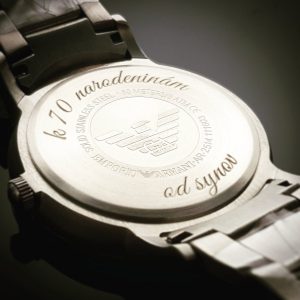In a Nutshell
Some watches can be engraved, depending on the watch material and existing engravings, but there are key factors you need to keep in mind before you put your watch under the chisel
Background and Introduction
Getting jewellery engraved is a marvellous way to show someone you care. Sometimes the engraving is romantic, such as engravings for anniversaries and wedding rings.
Sometimes it can be humorous, as Paul asks to get a crackerjack ring engraved for Holly Golightly in Breakfast at Tiffany’s.
Of course, many luxury watches can be engraved – but there are pros and cons.
Let’s take a closer look at which watches can be engraved, along with the pros and cons of doing so.
Which Watches Can Be Engraved?
The most common place for a watch engraving is on the back.

Elegant engraving on an Emporio Armani watch
As such, when deciding whether or not to get your watch engraved, you’ll want to check if the material forming the metal back of your watch is capable of being engraved.
While metals such as steel should be fine, softer metals, plastic, and glass might crack, while others might be too hard to engrave.
Should You Engrave Your Watch?
In addition, some watches feature brand stamps, registration numbers, and other identifying marks on the back.
Needless to say, you likely won’t want to deface these markings.
What’s more, it isn’t as though your watch is a huge object to engrave to begin with, and these markings mean there’ll be even less room for an engraving.

Engraving the side of the watch case is a good option if the back is not possible
In these cases, you’ll want to refrain from having the watch engraved.
Brand markings aren’t the only thing you risk defacing if you engrave certain watches.
Timepieces with transparent backs designed to show the inner workings of the watch can be quite elegant and unique.
They are also yet another example of a type of watch you’ll likely not want to engrave.
Finally, if you own an antique watch, you may not want to disrupt the vintage appearance or delicate features with an engraving.
Watch Engraving Pros
One of the biggest upsides of customising a watch is that it can be a less expensive way of introducing a little flair into your luxury watch game.
A top-flight luxury watch can be expensive, as can all of the maintenance work that comes with keeping it in good working condition.
A Rolex can cost several hundred dollars at minimum, and that isn’t even including the duties you might have to pay on international products.
A less expensive way of enjoying a luxury watch, therefore, may be to purchase an inexpensive option and customise it with an engraving.
In addition, customising your watch can be a great way to show someone you care.
If you are getting a watch for that special someone for their birthday, anniversary, or other major life event, having it engraved can be a great way of adding an extra stylistic touch without having to pay a ton of money.
Watch Engraving Cons
The biggest downside of engraving a watch is that doing so can cause the watch to lose value – especially if done badly!
The value of a vintage item often comes from its pristine nature.

You probably want to engrave this vintage Patek Phillip, worth over $9k, very carefully indeed!
While it might be nice to give your husband or wife an engraved watch for their birthday, the engraving process is likely to ruin the value of an older vintage watch.
If that is the primary reason you bought it, engraving probably isn’t a good idea.
Engraving is also something that typically voids the warranty for a watch, at least as far as its backside is concerned. Service stations will often not work on watches that have been repaired.
By keeping these pros and cons in mind and understanding which types of watches can and cannot be engraved, you can make the right choice for your luxury watch.

